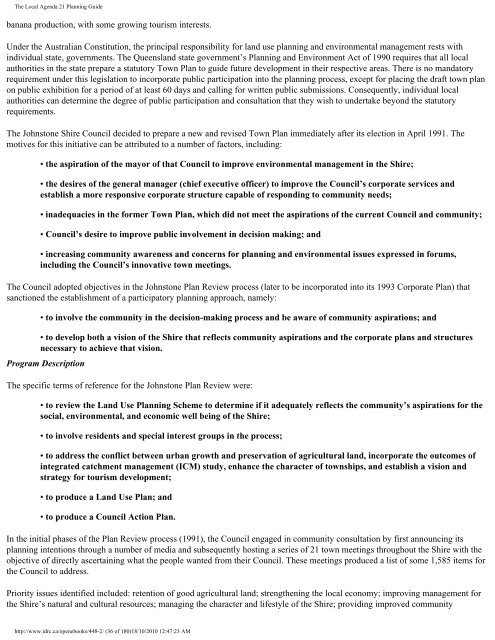The Local Agenda 21 Planning Guide - Democrats Against UN ...
The Local Agenda 21 Planning Guide - Democrats Against UN ...
The Local Agenda 21 Planning Guide - Democrats Against UN ...
You also want an ePaper? Increase the reach of your titles
YUMPU automatically turns print PDFs into web optimized ePapers that Google loves.
<strong>The</strong> <strong>Local</strong> <strong>Agenda</strong> <strong>21</strong> <strong>Planning</strong> <strong>Guide</strong><br />
banana production, with some growing tourism interests.<br />
Under the Australian Constitution, the principal responsibility for land use planning and environmental management rests with<br />
individual state, governments. <strong>The</strong> Queensland state government’s <strong>Planning</strong> and Environment Act of 1990 requires that all local<br />
authorities in the state prepare a statutory Town Plan to guide future development in their respective areas. <strong>The</strong>re is no mandatory<br />
requirement under this legislation to incorporate public participation into the planning process, except for placing the draft town plan<br />
on public exhibition for a period of at least 60 days and calling for written public submissions. Consequently, individual local<br />
authorities can determine the degree of public participation and consultation that they wish to undertake beyond the statutory<br />
requirements.<br />
<strong>The</strong> Johnstone Shire Council decided to prepare a new and revised Town Plan immediately after its election in April 1991. <strong>The</strong><br />
motives for this initiative can be attributed to a number of factors, including:<br />
• the aspiration of the mayor of that Council to improve environmental management in the Shire;<br />
• the desires of the general manager (chief executive officer) to improve the Council’s corporate services and<br />
establish a more responsive corporate structure capable of responding to community needs;<br />
• inadequacies in the former Town Plan, which did not meet the aspirations of the current Council and community;<br />
• Council’s desire to improve public involvement in decision making; and<br />
• increasing community awareness and concerns for planning and environmental issues expressed in forums,<br />
including the Council’s innovative town meetings.<br />
<strong>The</strong> Council adopted objectives in the Johnstone Plan Review process (later to be incorporated into its 1993 Corporate Plan) that<br />
sanctioned the establishment of a participatory planning approach, namely:<br />
• to involve the community in the decision-making process and be aware of community aspirations; and<br />
• to develop both a vision of the Shire that reflects community aspirations and the corporate plans and structures<br />
necessary to achieve that vision.<br />
Program Description<br />
<strong>The</strong> specific terms of reference for the Johnstone Plan Review were:<br />
• to review the Land Use <strong>Planning</strong> Scheme to determine if it adequately reflects the community’s aspirations for the<br />
social, environmental, and economic well being of the Shire;<br />
• to involve residents and special interest groups in the process;<br />
• to address the conflict between urban growth and preservation of agricultural land, incorporate the outcomes of<br />
integrated catchment management (ICM) study, enhance the character of townships, and establish a vision and<br />
strategy for tourism development;<br />
• to produce a Land Use Plan; and<br />
• to produce a Council Action Plan.<br />
In the initial phases of the Plan Review process (1991), the Council engaged in community consultation by first announcing its<br />
planning intentions through a number of media and subsequently hosting a series of <strong>21</strong> town meetings throughout the Shire with the<br />
objective of directly ascertaining what the people wanted from their Council. <strong>The</strong>se meetings produced a list of some 1,585 items for<br />
the Council to address.<br />
Priority issues identified included: retention of good agricultural land; strengthening the local economy; improving management for<br />
the Shire’s natural and cultural resources; managing the character and lifestyle of the Shire; providing improved community<br />
http://www.idrc.ca/openebooks/448-2/ (36 of 180)18/10/2010 12:47:23 AM










